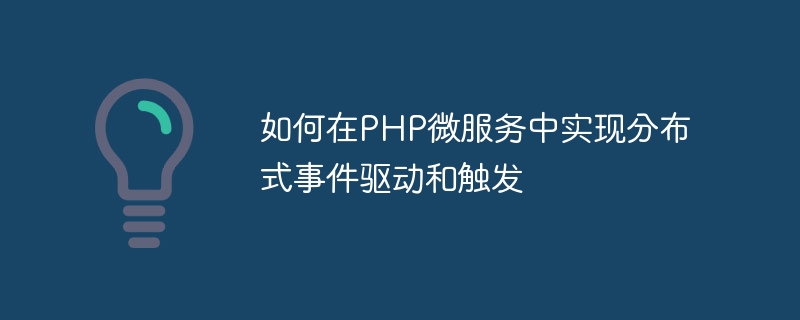

How to implement distributed event driving and triggering in PHP microservices
With the popularity of cloud computing and microservice architecture, distributed systems have become the basis for many large-scale applications Standard for the program. In distributed systems, event-driven architecture has become a common design pattern to decouple the dependencies between services and improve the scalability and maintainability of the system. In this article, we will explore how to implement distributed event driving and triggering in PHP microservices and provide specific code examples.
1. Design Ideas
Before implementing distributed event driving and triggering, we need to clarify the following concepts:
Based on the above concepts, we can design a simple distributed event-driven and triggering system. The specific implementation steps are as follows:
class UserRegisteredEvent {
public $userId;
public $email;
public function __construct($userId, $email) {
$this->userId = $userId;
$this->email = $email;
}
}class EventPublisher {
private $queue;
public function __construct($queue) {
$this->queue = $queue;
}
public function publish($event) {
$message = serialize($event);
$this->queue->push($message);
}
}class EventSubscriber {
private $handlers = [];
public function subscribe($event, $handler) {
$this->handlers[$event] = $handler;
}
public function handle($message) {
$event = unserialize($message);
$eventName = get_class($event);
if (isset($this->handlers[$eventName])) {
$handler = $this->handlers[$eventName];
$handler($event);
}
}
}class EventBus {
private $queue;
public function __construct($queue) {
$this->queue = $queue;
}
public function publish($event) {
$message = serialize($event);
$this->queue->enqueue($message);
}
public function subscribe($subscriber) {
while (true) {
$message = $this->queue->dequeue();
$subscriber->handle($message);
}
}
}2. Sample application
Now that we have completed the design and implementation of the distributed event-driven and triggering system, next We can illustrate its use with a simple example.
Suppose we have a microservice for user registration. When the user successfully registers, the service will publish an event named "UserRegisteredEvent", and other services that have subscribed to the event will receive this event and respond accordingly. processing. The following is an example code:
// 实例化事件发布者
$eventPublisher = new EventPublisher($queue);
// 实例化事件订阅者
$eventSubscriber = new EventSubscriber();
// 定义事件处理函数
$eventHandler = function($event) {
// 处理用户注册成功事件的代码
echo "用户注册成功:{$event->userId}, {$event->email}" . PHP_EOL;
};
// 订阅事件
$eventSubscriber->subscribe('UserRegisteredEvent', $eventHandler);
// 当用户注册成功时,发布事件
$event = new UserRegisteredEvent(1, 'test@example.com');
$eventPublisher->publish($event);
// 开始监听事件总线
$eventBus = new EventBus($queue);
$eventBus->subscribe($eventSubscriber);In the above example, by instantiating the event publisher and event subscriber, and defining the event processing function, we can publish the user registration success event to the event bus, and other subscriptions The service that receives the event will receive the event and handle it accordingly.
3. Summary
Distributed event driving and triggering is a common design pattern, and its implementation in PHP microservices is relatively simple. By using message queues and subscription-publish patterns, we can achieve decoupling and flexibility between services and improve the scalability and maintainability of the system. I hope this article will help you implement distributed event driving and triggering in PHP microservices.
(Note: The above code is only an example. Actual use may require more complex processing of event publishing and subscription, such as using event schedulers, event centers, etc.)
The above is the detailed content of How to implement distributed event driving and triggering in PHP microservices. For more information, please follow other related articles on the PHP Chinese website!